高三英语时态复习
- 格式:ppt
- 大小:148.50 KB
- 文档页数:17
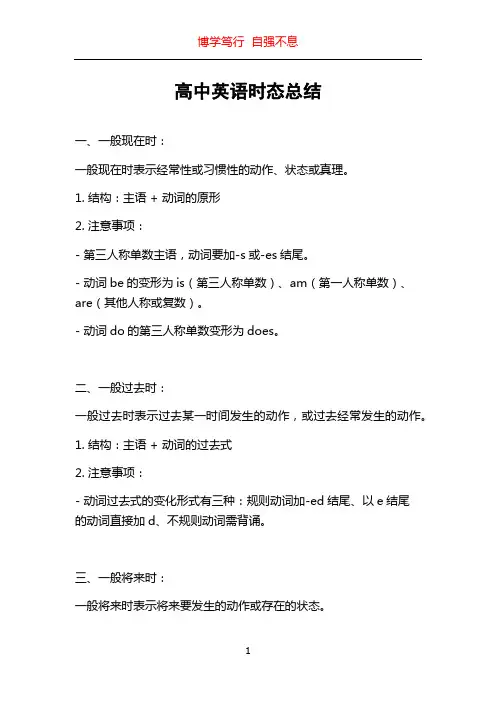
高中英语时态总结一、一般现在时:一般现在时表示经常性或习惯性的动作、状态或真理。
1. 结构:主语 + 动词的原形2. 注意事项:- 第三人称单数主语,动词要加-s或-es结尾。
- 动词be的变形为is(第三人称单数)、am(第一人称单数)、are(其他人称或复数)。
- 动词do的第三人称单数变形为does。
二、一般过去时:一般过去时表示过去某一时间发生的动作,或过去经常发生的动作。
1. 结构:主语 + 动词的过去式2. 注意事项:- 动词过去式的变化形式有三种:规则动词加-ed结尾、以e结尾的动词直接加d、不规则动词需背诵。
三、一般将来时:一般将来时表示将来要发生的动作或存在的状态。
1. 结构:主语 + will + 动词的原形2. 注意事项:- 当主语为第一人称时,可用shall代替will。
- 当表示将来的时间副词或状语连用时,将来时常和动词的原形连用。
四、现在进行时:现在进行时表示现在正在发生的动作。
1. 结构:主语 + am/is/are + 动词的ing形式2. 注意事项:- 动词-ing形式的构成规则为动词原形结尾加-ing。
- 动词末尾的e需去掉,再加-ing。
- 重读闭音节,末尾只有一个辅音字母时,应将末尾辅音字母双写,再加-ing。
五、过去进行时:过去进行时表示过去某一时间正在进行的动作。
1. 结构:主语 + was/were + 动词的ing形式2. 注意事项:- 动词-ing形式的构成规则同现在进行时。
- 句中使用过去进行时时,一般还需要使用表状态动词的动词-ing 形式。
六、将来进行时:将来进行时表示将来某一时间正在进行的动作。
1. 结构:主语 + will be + 动词的ing形式2. 注意事项:- 动词-ing形式的构成规则同现在进行时。
七、一般过去将来时:一般过去将来时表示过去的某个过去时间点本来要发生的事情,但实际上未发生。
1. 结构:主语 + would + 动词的原形2. 注意事项:- would在句中只表示动词的一种形式,无人称和数的变化。
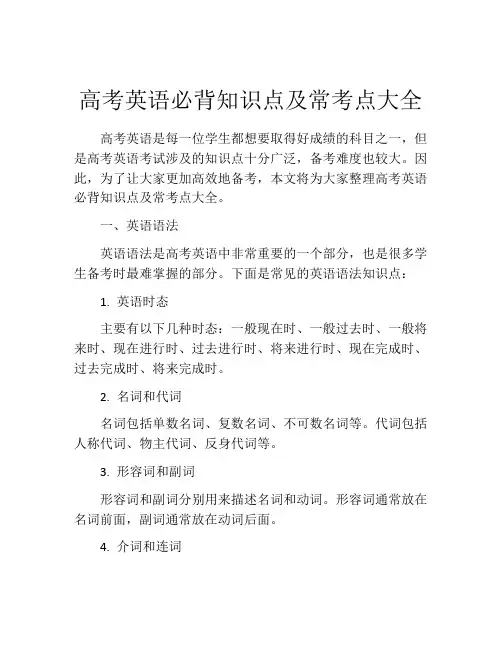
高考英语必背知识点及常考点大全高考英语是每一位学生都想要取得好成绩的科目之一,但是高考英语考试涉及的知识点十分广泛,备考难度也较大。
因此,为了让大家更加高效地备考,本文将为大家整理高考英语必背知识点及常考点大全。
一、英语语法英语语法是高考英语中非常重要的一个部分,也是很多学生备考时最难掌握的部分。
下面是常见的英语语法知识点:1. 英语时态主要有以下几种时态:一般现在时、一般过去时、一般将来时、现在进行时、过去进行时、将来进行时、现在完成时、过去完成时、将来完成时。
2. 名词和代词名词包括单数名词、复数名词、不可数名词等。
代词包括人称代词、物主代词、反身代词等。
3. 形容词和副词形容词和副词分别用来描述名词和动词。
形容词通常放在名词前面,副词通常放在动词后面。
4. 介词和连词介词和连词用来连接词语,介词通常放在名词或代词前面,连词用来连接词语或句子。
5. 句型常见的句型有陈述句、疑问句、祈使句、感叹句等。
二、词汇高考英语中,词汇量是很重要的一个方面。
下面是高考英语常见的词汇知识点:1. 同义词和反义词同义词指的是意思相同或相近的词,反义词则指的是意思相反的词。
2. 前缀和后缀前缀和后缀指的是词根前面或后面的一些字母,用来改变词义。
3. 词形变化词形变化指的是单数名词变成复数名词,动词变化成不同的时态等。
4. 词义辨析词义辨析指的是相似但细微差异的单词之间的区别,如effect和affect等。
三、阅读理解阅读理解是高考英语中的重头戏,通常占据比较多的分数,因此要认真准备。
下面是阅读理解需要注意的知识点:1. 词汇理解要能够正确理解课文中的词汇,而不是仅根据字面去理解,同时还要掌握一些固定的短语和表达方式。
2. 语法分析要能够正确理解课文中的语法结构,包括句子主谓宾、修饰语、同位语等。
3. 推理判断要能够根据课文中的信息进行推理和判断,并能够理解作者的观点和态度。
四、写作高考英语中的写作部分通常包括作文和翻译。
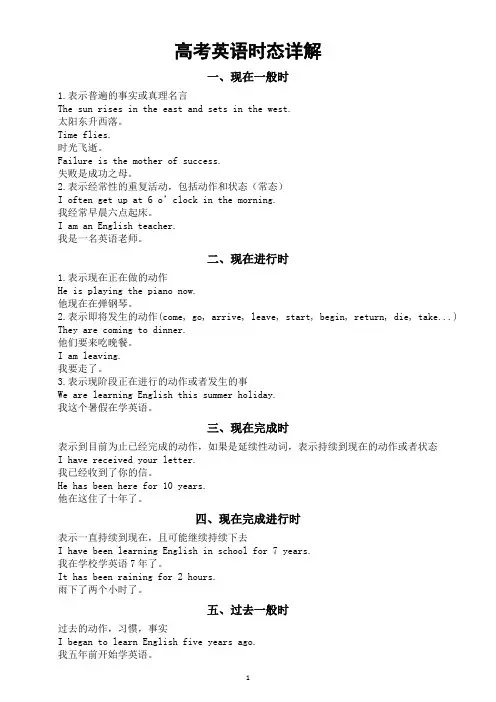
高考英语时态详解一、现在一般时1.表示普遍的事实或真理名言The sun rises in the east and sets in the west.太阳东升西落。
Time flies.时光飞逝。
Failure is the mother of success.失败是成功之母。
2.表示经常性的重复活动,包括动作和状态(常态)I often get up at 6 o’clock in the morning.我经常早晨六点起床。
I am an English teacher.我是一名英语老师。
二、现在进行时1.表示现在正在做的动作He is playing the piano now.他现在在弹钢琴。
2.表示即将发生的动作(come, go, arrive, leave, start, begin, return, die, take...) They are coming to dinner.他们要来吃晚餐。
I am leaving.我要走了。
3.表示现阶段正在进行的动作或者发生的事We are learning English this summer holiday.我这个暑假在学英语。
三、现在完成时表示到目前为止已经完成的动作,如果是延续性动词,表示持续到现在的动作或者状态I have received your letter.我已经收到了你的信。
He has been here for 10 years.他在这住了十年了。
四、现在完成进行时表示一直持续到现在,且可能继续持续下去I have been learning English in school for 7 years.我在学校学英语7年了。
It has been raining for 2 hours.雨下了两个小时了。
五、过去一般时过去的动作,习惯,事实I began to learn English five years ago.我五年前开始学英语。

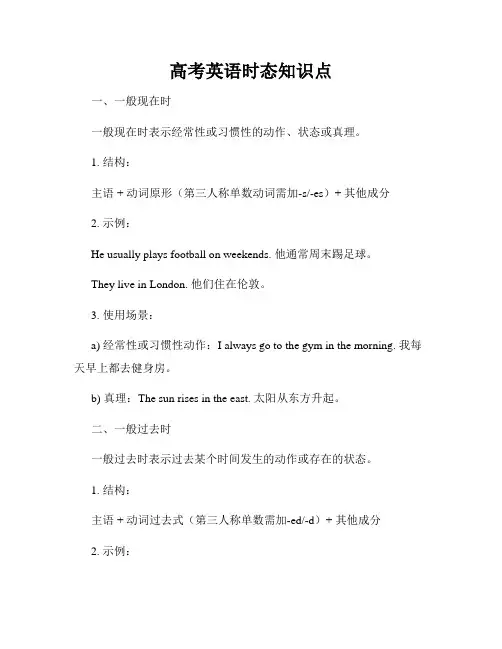
高考英语时态知识点一、一般现在时一般现在时表示经常性或习惯性的动作、状态或真理。
1. 结构:主语 + 动词原形(第三人称单数动词需加-s/-es)+ 其他成分2. 示例:He usually plays football on weekends. 他通常周末踢足球。
They live in London. 他们住在伦敦。
3. 使用场景:a) 经常性或习惯性动作:I always go to the gym in the morning. 我每天早上都去健身房。
b) 真理:The sun rises in the east. 太阳从东方升起。
二、一般过去时一般过去时表示过去某个时间发生的动作或存在的状态。
1. 结构:主语 + 动词过去式(第三人称单数需加-ed/-d)+ 其他成分2. 示例:She studied English literature at university. 她在大学期间学习英国文学。
They visited their grandparents last summer. 他们去年夏天拜访了他们的祖父母。
3. 使用场景:a) 过去某个时间的动作:We went to the cinema last night. 昨晚我们去看电影了。
b) 过去存在的状态:The city was very crowded during the holiday. 假期期间这个城市非常拥挤。
三、一般将来时一般将来时表示将要发生的动作或存在的状态。
1. 结构:主语 + will/shall + 动词原形 + 其他成分2. 示例:I will visit my grandparents next month. 下个月我将去拜访我的祖父母。
She won't go to the party tonight. 今晚她不会去参加派对。
3. 使用场景:a) 将要发生的动作:They will arrive at the airport in two hours. 他们将在两小时内到达机场。
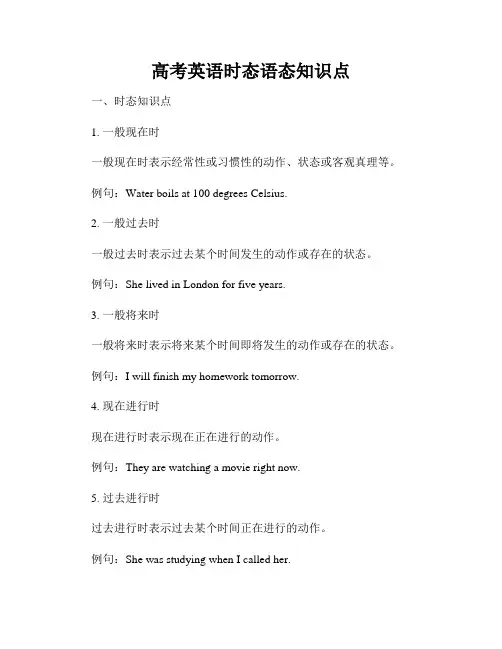
高考英语时态语态知识点一、时态知识点1. 一般现在时一般现在时表示经常性或习惯性的动作、状态或客观真理等。
例句:Water boils at 100 degrees Celsius.2. 一般过去时一般过去时表示过去某个时间发生的动作或存在的状态。
例句:She lived in London for five years.3. 一般将来时一般将来时表示将来某个时间即将发生的动作或存在的状态。
例句:I will finish my homework tomorrow.4. 现在进行时现在进行时表示现在正在进行的动作。
例句:They are watching a movie right now.5. 过去进行时过去进行时表示过去某个时间正在进行的动作。
例句:She was studying when I called her.6. 将来进行时将来进行时表示将来某个时间正在进行的动作。
例句:This time next week, we will be traveling in Japan.7. 现在完成时现在完成时表示过去某个时间发生的动作对现在造成的影响或结果。
例句:I have finished my homework.8. 过去完成时过去完成时表示过去某个时间或动作之前已经发生的动作或存在的状态。
例句:She had already left when I arrived.9. 将来完成时将来完成时表示将来某个时间之前已经完成的动作或存在的状态。
例句:By this time tomorrow, I will have finished my report.二、语态知识点1. 主动语态主动语态表示主语是动作的执行者。
例句:She wrote a letter.2. 被动语态被动语态表示主语是动作的承受者,强调动作对主语的影响。
例句:The letter was written by her.3. 进行时的被动语态进行时的被动语态表示主语正在被动地进行某个动作。

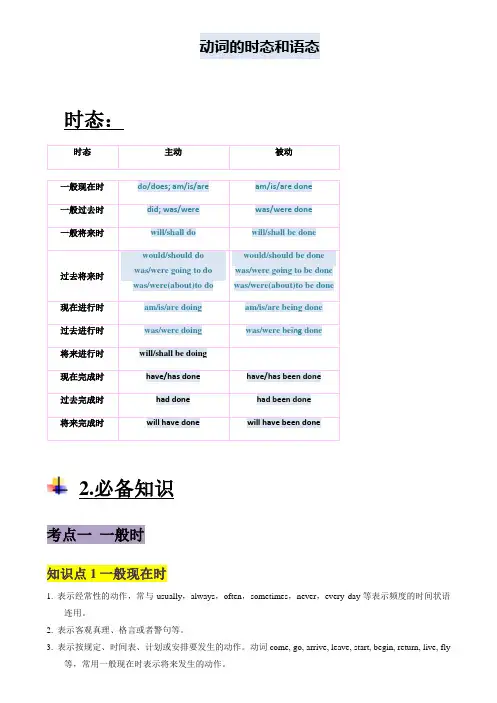
动词的时态和语态时态:时态主动被动一般现在时do/does; am/is/are am/is/are done一般过去时did; was/were was/were done 一般将来时will/shall do will/shall be done过去将来时would/should dowas/were going to dowas/were(about)to dowould/should be donewas/were going to be donewas/were(about)to be done现在进行时am/is/are doing am/is/are being done过去进行时was/were doing was/were be ing done将来进行时will/shall be doing现在完成时have/has done have/has been done过去完成时had done had been done将来完成时will have done will have been done2.必备知识考点一一般时知识点1一般现在时1.表示经常性的动作,常与usually,always,often,sometimes,never,every day等表示频度的时间状语连用。
2.表示客观真理、格言或者警句等。
3.表示按规定、时间表、计划或安排要发生的动作。
动词come, go, arrive, leave, start, begin, return, live, fly等,常用一般现在时表示将来发生的动作。
4.在时间、条件等状语从句中常用一般现在时代替一般将来时。
5.以here/there开头引导的倒装句,表示正在发生的动作/状态6.用于文章标题、图片说明、电影说明、戏剧内容及场景解说等。
知识点2一般过去时1. 表示在过去发生的一次性动作或习惯性动作或存在的状态,常用yesterday,last year,in 1995,the other day等作时间状语。
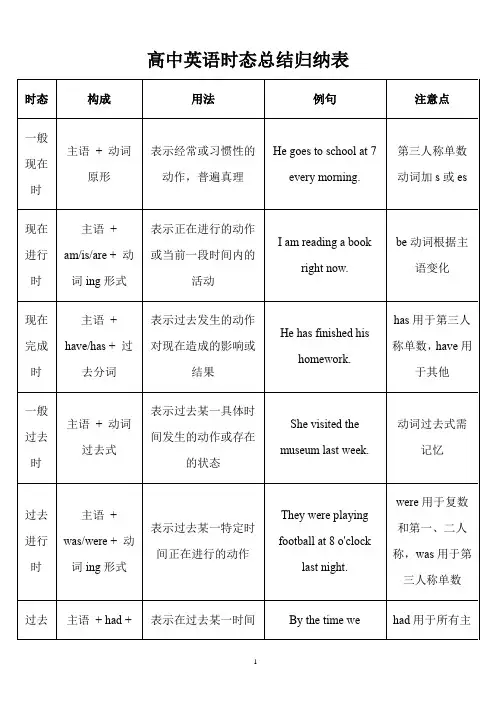
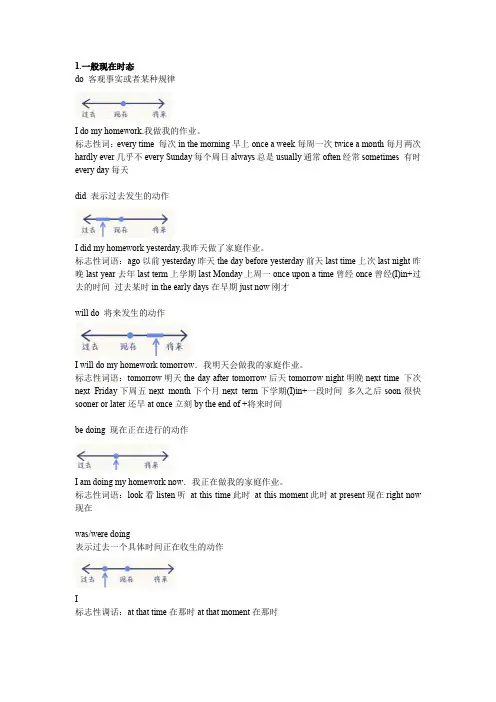
1.一般现在时态do 客观事实或者某种规律I do my homework.我做我的作业。
标志性词:every time 每次in the morning早上once a week每周一次twice a month每月两次hardly ever几乎不every Sunday每个周日always总是usually通常often经常sometimes 有时every day每天did 表示过去发生的动作I did my homework yesterday.我昨天做了家庭作业。
标志性词语:ago以前yesterday昨天the day before yesterday前天last time上次last night昨晚last year去年last term上学期last Monday上周一once upon a time曾经once曾经(I)in+过去的时间过去某时in the early days在早期just now刚才will do 将来发生的动作I will do my homework tomorrow.我明天会做我的家庭作业。
标志性词语:tomorrow明天the day after tomorrow后天tomorrow night明睌next time 下次next Friday下周五next month下个月next term下学期(I)in+一段时间多久之后soon很快sooner or later还早at once立刻by the end of +将来时间be doing 现在正在进行的动作I am doing my homework now.我正在做我的家庭作业。
标志性词语:look看listen听at this time此时at this moment此时at present现在right now 现在was/were doing表示过去一个具体时间正在收生的动作I标志性调话:at that time在那时at that moment在那时will be doing在将来正在发生的动作I will be doing my homework at 9:00.9点的时候,我会正在政作业。

高考英语时态知识大全汇总时态在英语中扮演着非常重要的角色,准确使用时态能够帮助我们清晰地表达自己的意思,因此在高考英语考试中也是一个重要的知识点。
下面是高考英语时态知识的详细介绍。
一、一般现在时一般现在时表示经常性的、习惯性的动作、事实或者真理。
结构:主语 + 动词原形(第三人称单数加s或es)1. 表示经常性的动作或习惯例句:I always get up early in the morning.I often go to the park on weekends.2. 表示客观真理或普遍规律例句:The sun rises in the east.Water boils at 100 degrees Celsius.二、一般过去时一般过去时表示过去某个时间发生的动作或存在的状态。
结构:主语 + 动词的过去式1. 表示过去发生的某个具体动作例句:Yesterday, I went to the cinema with my friends.They visited their grandparents last week.2. 表示过去的某个状态或习惯性动作例句:He used to swim every day when he was young.She lived in London for five years.三、一般将来时一般将来时表示将来某个时间会发生的动作或存在的状态。
结构:主语 + will + 动词原形1. 表示未来发生的某个具体动作例句:I will visit my grandparents next week.She will go shopping tomorrow.2. 表示预测、打算或意愿例句:I think it will rain tonight.They will have a party to celebrate their anniversary.四、现在进行时现在进行时表示正在进行的动作。
一、时态的数轴的思维导图have been de nghave done动词的时态和语态will do had donewill have done Past pastis doingpresentwill be doing future would have d ( ne考点一、现在时一、一般现在时1.含义1)经常性或习惯性的动作,常与表示频率的时间状语连用。
I leave home fbr school at 7 every morning.2)客观真理,客观存在,科学事实。
The earth moves around the sun.Shanghai lies in the cast of China.3)现在时刻的状态、能力、性格、个性。
Ann Wang writes good English but does not speak well.4) not....until....as...hen, before, after, not....until....等)、条件状语从句(if, unless, as long as...)中常用一般现在时表示将来Anything will become boring if you do it repetitively.As long as it doesn't rain tomorrow ,we will have a trip on schedule.2.常用的时间状语频率副词:often, usually, sometimes, always, seldom, hardly, never2)短语:every (day 等),once/twice a (week 等),on (Sunday 等),in the (morning 等),at (eight) , now and then, from time to timeHe usually goes to school by bike.3.谓语切词形式:do/does.谓语动词的被动语态:am/is/are doneIn the spoken English of some areas in the U.S, the " r" sounds at the end of the words arc dropped.练习:用所给单词的适当形式填空How close parents are to their children(have) a strong influence on the development of the children's characters.1.If your call is not answered within two minutes, you(advise) to hang up and dial again.2.We will be losing money this year unless that new economic plan of yours(work) miracle.3.It(turn) out that making a plan is easier than carrying it out.4.The growth of part-time and flexible working patterns, and of training and retraining schemes, (allow) more women to take advantage of employment opportunities.二、现在进行时.定义1)表示说话时正在进行的动作及行为;2)表示现阶段(近段时间)正在进行的动作。
高考英语科目必考知识点整理高考英语必考点总结十六种时态:一般现在时,一般过去时,一般将来时,一般过去将来时;现在进行时,过去进行时,将来进行时,过去将来进行时;现在完成时,过去完成时,将来完成时,过去将来完成时;现在完成进行时,过去完成进行时,将来完成进行时,过去将来完成进行时.一、一般现在时:take形式为原形例子:It take sme five years to finish the painting。
这幅画花了我十年功夫1.概念:经常、反复发生的动作或行为及现在的某种状况。
2.时间状语:always,usually,often,sometimes,everyweek(day,year,month…),once a week,on Sundays,3.基本结构:动词原形(如主语为第三人称单数,动词上要改为第三人称单数形式)二、一般过去时:take形式为took.1.概念:过去某个时间里发生的动作或状态;过去习惯性、经常性的动作、行为。
2.时间状语:ago,yesterday,the day beforeyesterday,lastweek,last(year,night,month…),in1989,just now,at the age of 5,one day,long long ago,once up on a time,etc.3.基本结构:be动词;行为动词的过去式三、现在进行时:take形式为am/is/are taking1.概念:表示现阶段或说话时正在进行的动作及行为。
2.时间状语:now,at this time,these days,etc.3.基本结构:am/is/are+doing四、过去进行时:take形式为was/were+taking1.概念:表示过去某段时间或某一时刻正在发生或进行的行为或动作。
2.时间状语:at this time yesterday,at that time或以when引导的谓语动词是一般过去时的时间状语等。
常用英语时态总复习按构成和状态可分四类:一般时(单个V原/ V-ed,可借助于助动词do[多形] + V原构成否定句和疑问句)、进行时(借助于助动词be[多形]+V-ing)、将来时(借助于助动词will[多形]+ V原)、完成时(借助于助动词have[多形]+ V-ed)动词时态一:一般现在时①表示经常或习惯性的动作或存在的状态。
②表示主语通常的能力、兴趣爱好、和性格特征。
③表示客观的事实或真理。
④表示按照时刻表或已经计划安排好的将来行为。
(只限于是go, come, leave, arrive, begin, start, take off, stop, be等表示开始或移动意义的词。
)⑤在时间状语从句和条件状语从句中,主句用一般将来时(will+动词原形),从句中用一般现在时表将来。
当主语是第三人称时,谓语动词要用第三人称单数形式,加-s/es。
除此之外都用动词原形。
1.He______(be, am, is, are) a teacher at No. 2 Middle School.2.He______(have, has) classes in the afternoon.3.He______(get, gets) up at half past six every morning.4.He always _____(come, comes ) to school on time.5.He ______(study, studies) very hard at his lesson.6.One and two _____(be, is, are) three.7.Blue and yellow _____(make, makes) green.8.The earth _____(move, moves) round the sun.9.I will go there if I ____( be, will be, am, is, are) free tomorrow.10.I will go there when I _____(have, will have, has) time tomorrow.11.He won’t come to the party unless he _____(be, will be, am, is, are) invited.12.I’ll wait here until my mother ____(come, comes, will come) back.13.Please return the book to the library as soon as you ______(finish, finishes, will finish) reading it.14.Once you _____(see, sees, will see) him, you will never forget him.时间状语:--- sometimes/often/usually/always/now/never/seldom/every morning/once a month---动词时态二:一般过去时(提示:使用动词的过去式)表示具体的某个过去时间所发生的动作或所处的状态。
1、一般现在时主要用来表示人、事物的现在状况和特点;表示经常或习惯性的动作,句子中常有often, always, from time to time 等时间状语;表示客观规律和永恒真理等。
He usually goes to work at 7 o’clock every morning.The earth goes around the sun.Guangzhou is situated in the south of China.考点一:表示永恒的真理,即使出现在过去的语境中,仍用一般现在时。
如:I learned that the earth goes around the sun when I was in primary school.考点二:在时间和条件状语从句中,代替一般将来时;常用的引导词有:时间:when, until, after, before, as soon as, once, the moment/the minute, the day; 条件:if, unless, provided.If he accepts the job, he will get more money soon.考点三:在make sure (certain), see to it, mind, care, matter +宾语从句,从句用一般现在时代替一般将来时。
So long as he works hard, I don’t mind when he finishes the experiment.只要他努力工作,我不介意他什么时候做完试验。
考点四:在the more… the more … (越…越…) 句型中, 若主句是一般将来时, 从句通常用一般现在时。
The harder you study, the better results you will get.2、现在进行时表说话时或目前一段时间内正在进行的活动:或表感情色彩,加强语气。